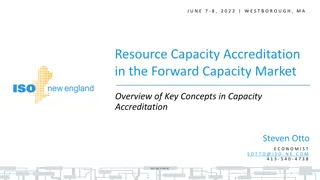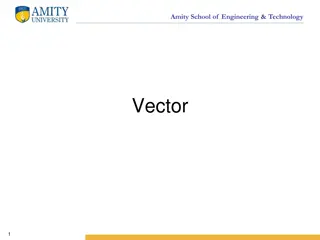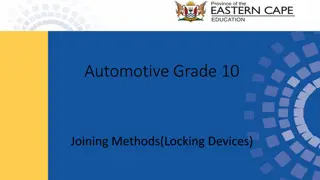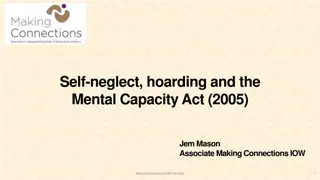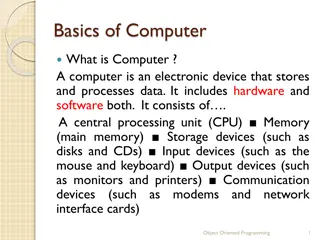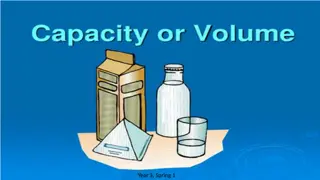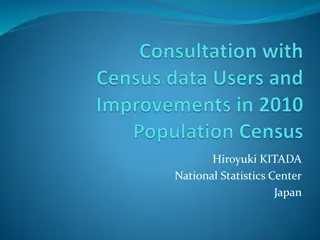Challenges and Innovations in CXL 3.0 Dynamic Capacity Devices
Exploring the intricacies of CXL 3.0 Dynamic Capacity Devices presented at the LPC CXL micro conference 2023, focusing on asynchronous memory operations, partial extents, interleaving flow challenges, and memory sharing. The discussion delves into the dynamic capacity feature allowing memory changes without system restart and highlights the industry use cases and user API considerations. Moreover, the presentation touches on asynchronous memory release, partial extent handling in Linux, and interleaving challenges in dynamic capacity devices.
Download Presentation

Please find below an Image/Link to download the presentation.
The content on the website is provided AS IS for your information and personal use only. It may not be sold, licensed, or shared on other websites without obtaining consent from the author. Download presentation by click this link. If you encounter any issues during the download, it is possible that the publisher has removed the file from their server.
E N D
Presentation Transcript
Plumbing challenges in Dynamic Capacity Devices LPC CXL micro conference 2023 Navneet Singh, Ira Weiny, and Jonathan Cameron
Agenda Introduction Asynchronous add/release of memory Partial extents Interleaving flow challenges Force release support Host user interactions Backup Memory sharing
What are we after? Highlight the challenges brought in by CXL 3.0 DCD feature Identify Industry use cases Ensure User APIs provide for those use cases Open discussion/feedback/suggestions Other?
CXL Dynamic Capacity Device Introduction Dynamic capacity device is a CXL3.0 feature which allows memory capacity to change dynamically without host system restart CXL device can have up to 8 Dynamic Capacity regions per host Dynamic capacity is added/released in a form of memory extent which is defined with start address, length and user tags CXL device maintains extent list per host Dynamic capacity add/release operation are triggered through Fabric Manager Dynamic capacity at the host is provisioned as DAX device
Asynchronous DC Memory Release User pinned memory Complete or Partial Extent Memory not released on DC release memory request as its in the use. Once memory is free then it needs to be returned to the device asynchronously Based on in use device dax mappings Kernel Pinned memory Complete or Partial Extent Memory not released on DC release memory request as its pinned in the kernel Memory released when mapping is released (unlikely to happen)
Partial extents Any strong use case in Linux? Spec allows the device to request release of sub-extents (vs what was previously added) the host to accept part of an extent offered from the device sub-extents not supported for now [based on discord discussion]
DCD Interleaving Challenges Runtime construct/destroy the memory range from the interleaved memory devices extents notified through DC add or release interrupts. Extent Add - Once Interleaving set is complete after receiving the last add extent from the interleaved memory device, It s driver will construct the HPA range, surface the extents to the user space after the last extent. Extent Remove- First release extent from the interleaving will leads to removal of interleaved memory range extent from user space.
Forced Dynamic capacity support If memory is pinned for long time, then device can raise forced dynamic capacity release request Device will not wait for the response and will remove the memory Any access to that memory by the kernel will lead to poison Force ignored by Linux software [dev_err_ratelimited()] Extent is leaked Probably will require host reboot
Traditional DAX regions DAX Regions are created on existing memory DAX devices are created linearly DAX devices can map different ranges within the region Limited control over exactly where the DAX ranges are DAX dev DAX dev DAX dev DAX range DAX range DAX range DAX range DAX Region
Sparse DAX regions Created as a container for potential memory Concept similar to the DC Regions DAX device creation initially still linear But can adapt to more control [tags?] DAX dev DAX dev DAX dev DAX range DAX range DAX range DAX range DAX Region DAX region extent DAX region extent DAX region extent
Git trees In review Kernel RFC v3 soon Discussions on discord QEMU https://lore.kernel.org/all/20231107180907.553451-1- nifan.cxl@gmail.com/ https://gitlab.com/jic23/qemu/-/commits/cxl-2023-11-02
Extents What is an extent? A range of memory in region block size chunks Multiple extent objects in the code DC extent CXL DAX Region extent DAX Region extent
Dynamic Capacity Extent acceptance should a region be required for memory accept? spec requires region ensures CFMWS and decoder availability prior to memory acceptance allows for more flexible interactions with the host/orchestrator/FM








